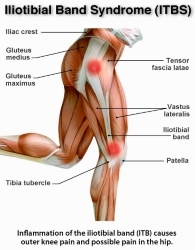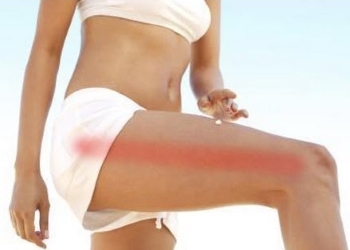The IT band (iliotibial band) is something you are only likely to hear about when it causes problems. A thick band of connective tissue and fascia, it runs from your hip to the outside of your knee, which is where it can be the source of pain. This is known as IT band syndrome. But a tight IT band can also lead to issues in your hip that result in lower back pain.
Table Of Contents
How Does The IT Band Cause Lower Back Pain

The IT band works along with other muscles to extend your hip and move your leg away from your body (abduction). It also helps to rotate your hip and therefore your leg, as well as stabilising your knee(1). Problems can develop when the IT band become inflamed from overuse. This is usually from running, cycling or any sudden increase in activity levels. The result is usually knee pain which comes on with exercise or walking. But because the IT band connects to your hip via your TFL (tensor fascia lata) muscle, it can also cause lower back pain.
As mentioned in other articles, the gluteus medius and other muscles of the buttocks can often be the undiagnosed cause of lower back pain. If they are tight or weak, other muscles will have to do more than their fair share to compensate. The result of which can be lower back pain or even injury. But this can begin further along the chain if the cause of your gluteus problems comes from a tight or inflamed IT band.
How To Treat Lower Back Pain Caused By The IT Band

The first step is to identify the cause of your tight IT band and avoid it, or at least make some changes where possible. If running is the culprit, try some different exercise for a while such as cycling or a cross trainer machine(2). This will help with the repetitive strain side of things that can cause and maintain inflammation.
The next step is to loosen up the IT band. Plus any other muscles along the chain that have lead to your lower back pain. A massage therapist will relieve any tightness, as well as specific areas of tension, knots or adhesions. This is also true of the gluteus (buttock) muscles and lower back muscles such as quadratus lumborum (QL). Stretching without massage can have limited benefit, such as pain relief, but the effect will only be temporary. The same goes for use of foam rollers. Things might seem better for a few hours but you will most likely wake up the next day back at square one.
Stretching and foam rollers can be a useful accompaniment to massage, but a deep-tissue massage or sports massage will be far more effective.
Book A Mobile Massage
If you would like to book a mobile massage in York please contact me on 07713 250352 or email david@massageinyork.co.uk. Includes sports massage, deep tissue massage and Swedish massage. For more information on booking click here
